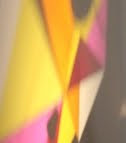when a thing is so beautiful i wish i'd made it myself...

somehow i ended up on this african sculpture/mask while searching for some old music photos on ebay. i swiped the image in the midst of some sort of chaotic bouncing around and hence i don't have the link to the listing that describes what this is - although i do remember it was in the $900 range if anyone is interested in it. the colors, the lines, the forms, and everything about its visual presence leaves me speechless, so i will refrain from connecting it to relevant "modern artworks" and stop writing anymore about it, other than to suggest you stare at it for a long while, at least long enough for it to begin seeping inside you, so that you can carry it with you wherever you go... i know i will!
sunday update: big thanks to greg (whose blog you should definitely check out), for sending me a link to this: In the Songye language, a mask is a kifwebe: this term has been given to masks representing spirits and characterized by striations. Depending on the region, it may be dark with white strips, or the reverse. The kifwebe masks embodied supernatural forces. The kifwebe society used them to ward off disaster or any threat. The masks, supplemented by a woven costume and a long beard of raffia bast, dance at various ceremonies. They are worn by men who act as police at the behest of a ruler, or to intimidate the enemy. It can be either masculine, if carved with a central crest, or feminine if displaying a plain coiffure. The size of the crest determines the magic power of the mask. Mask, colors, and costume all have symbolic meaning. The dancer who wears the male mask will display aggressive and uncontrolled behavior with the aim of encouraging social conformity, whereas the dancer who wears the female mask display more gentle and controlled movements and is assumed to be associated with reproduction ceremonies. The use of white on the mask symbolizes positive concepts such as purity and peace, the moon and light. Red is associated with blood and fire, courage and fortitude, but also with danger and evil. Female masks essentially reflect positive forces and appear principally in dances held at night, such as during lunar ceremonies and at the investiture or death of a ruler. The mask had also the capacity to heal by means of the supernatural force it was supposed to incorporate. The ritual of exorcism consisted of holding the sick man’s mask while a magician acted as if he were casting it into the fire. Kifwebekifwebe society – grooved shields, for example, are adorned with a central mask. Buffalo masks with a brown patina that have no stripes were used in hunting rituals. (lots more pictures here)
Labels: incredible pieces of sculpture, masks

5 Comments:
It has authority, but also resembles a child taking its first steps.
do you want to know what it is?
um... yeah...:-)
it's a kifwebe mask from the Songye tribe in Congo.
There's a nice writeup and gallery here:
http://www.zyama.com/songye/pics..htm
I didn't want to break the decontextualized spell of the incredible object, but they do sound pretty fascinating on their own.
holy moly! there's pictures of so many more... fantastic!!!! i'm going to add the part about masks to the post, it's totally interesting, and fortunately will not break 'the spell'... great, thanks a ton.
Post a Comment
<< Home